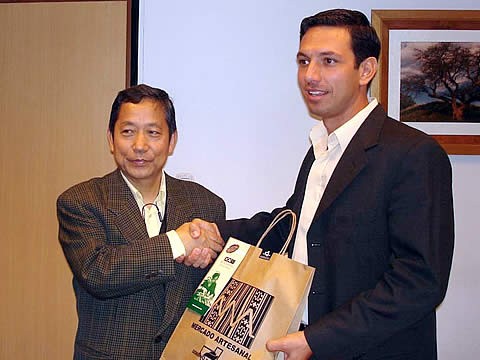 |
| Ono Katsumi, a senior volunteer with the Japanese International Cooperation Agency |
(VOVworld) – The hypnotic beauty of the imperial city of Hue and its people has captivated Ono Katsumi, a senior volunteer with the Japanese International Cooperation Agency. His love for Vietnam’s central region has driven Ono to discover all he can about Hue. And he hasn’t kept his discoveries to himself - he has become a bridge between Thua Thien - Hue and the Japanese people. Ono Katsumi talked recently about what he has been doing to VoV reporter Lan Anh.
Hue residents have become familiar with a slight Japanese man wearing a haversack, and carrying a camera, totally absorbed each day in taking notes and beautiful photos of Hue. Ono Katsumi says Hue holds a special attraction ‘21 years ago, I first came to Hue when it was very neglected. I returned to Hue last March and realized how spectacular it has become. I decided to choose Hue to introduce to my fellow-countrymen in Japan’.
Ono got to work immediately. As a senior expert with JICA, Ono works with Hue’s Department of Culture, Sports and Tourism which offers him many opportunities to explore the city’s tourism potential. He said ‘In the past, Japanese visitors just took tours of historic relic sites like the Hue Royal Palace. Since I came, I’ve found that in addition to relic sites, Hue has some captivating culture, nature, people, and cuisine. Japanese tourists either haven’t known about or have ignored these attractions, so I intend to promote them’.
During the past year, Ono contacted travel agents and the management boards of tourist attractions like Phuoc Tich ancient village, Thanh Tan Spa Resort, and Hue’s craft villages to gather interesting stories to tell the Japanese people. He also built a Japanese language website at www.vietnamhuetourism adding ‘In February, I set up a Japanese language website to update information about Hue regularly. For years, visitors have only known about the Hue Royal Palace – not the many other places they could visit in the city. Even Hue residents haven’t thought much about other potential tourist attractions’.
At www.vietnamhuetourism, you’ll find lots of information about Hue: brief profiles, colorful photos, and entertaining video clips.
Although Ono has been in Hue for more than a year, every new discovery increases his love for the city. He recalled ‘I first introduced Hue’s food, people, life, history, and my own daily experiences. I started to post the information on the web and received much feedback. I feel the Japanese people are beginning to like Hue. It’s not that the Japanese don’t know about Hue, but there are fewer advertisements and promotional programs about Hue than about Hanoi or Ho Chi Minh City. It’s a shame that Hue, a potential tourism leader hasn’t established tourists information centers to provide maps, guides, and tourist information. There are still very few tour guides who can speak English’.
Minh Tien, a Hue native, has worked closely with Japanese volunteers. She said ‘The information on the website is rich and updated regularly. I like Ono’s website and feel grateful to him’.
Hue is not as busy as Ho Chi Minh City, not as modern as Da Nang City, but its beauty is meditative, ancient and solemn. According to Ono, once you visit Hue and live there a while, you’ll notice things that exist nowhere but in the imperial city. There time seems to pass more slowly and everything seems to change very little. Katsumi noted ‘Through my website, a Japanese person whose father died in a Hue pagoda 40 years ago contacted me to look for information. It took me 83 hours of searching but finally I was successful, and I helped him and his family members receive the body. For the past 40 years, despite a succession of head monks that pagoda has remained unchanged. That’s one strange but fascinating thing about Hue’.